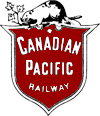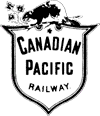







This World Wide Web article was created with a document from the Edith and Lorne Pierce Canadiana Collection at Queens University in Kingston, Ontario. Where appropriate, links to suitable photos have been added to the unknown author's text. The document is quoted here by OKthePK website under the provisions in Section 29 of the Canadian Copyright Modernization Act of 2011.
Yards - The main shops were commenced in August, 1903, and completed in July, 1905. Since this date, the following have been added, One car shop, tender and wheel shop, extension to power house, foundry, freight car shop, and mess building. They are situated about 2 1/2 miles west of the depot on the main line with the freight yard
on the main line with the freight yard and roundhouse between. The area fenced-in comprises 160 acres, and there is also a provision of 160 acres for the future extension north of the present fenced area, not yet fenced-in.
and roundhouse between. The area fenced-in comprises 160 acres, and there is also a provision of 160 acres for the future extension north of the present fenced area, not yet fenced-in.
The main shops face on a roadway, which is central to the shop site, and each building is placed so that it can be extended indefinitely without disturbing the layout of the works as a whole.
Tracks - There are about 15 miles of standard gauge tracks inside the fence for handling cars and materials to any portion of the works, and in addition there are about 5 miles of 20 inch narrow gauge tracks for handling light materials between buildings and stores.
Telephones - All shops are equipped with a local telephone system connecting with all foremen's offices, yards, etc., general offices, also two private lines to freight yards, and the general offices at the depot.
Fire Protection - The shops and yards are equipped with up-to-date fire fighting appliances. Every building is equipped with automatic sprinklers, and there are located at convenient places in the yards, 29 three-way independent gate hydrants, each hydrant being housed, and having 150 feet of fire hose, with nozzles and fittings. There are about five miles of fire mains laid in yards, ranging in size from 12 inch to 8 inch.
A constant pressure of about 45 pounds per square inch is kept on mains and automatic sprinklers, which in the event of fire is increased to 100 pounds per square inch by fire pumps situated in the Power House.
A volunteer fire brigade is organized among the workmen, and a rigid inspection is made every day of all fire equipment, a report being sent in daily to the officials of the state of every valve and hydrant, etc.
In addition, the yards are equipped with telegraphic fire stations, connecting with the power house and from thence to the City fire alarm system.
Sewage System - The Company has a complete sewage system inside the yards, having branches from all buildings feeding to a trunk sewer, 3 feet 6 inches by 2 feet 4 inches, egg shaped, which is connected to the City system near the stock yards.
Buildings - All the main buildings (except one car shop and the tender and wheel shop, which are all concrete) are of local brick on concrete foundations, and of mill construction, having "lean-to's" for fan houses and lavatories.
(except one car shop and the tender and wheel shop, which are all concrete) are of local brick on concrete foundations, and of mill construction, having "lean-to's" for fan houses and lavatories.
Water - The water for power, fire, and shop service is pumped from the Red River through an 8 inch C.I. pipe, connection being made to the City high pressure plant at the river, which supplies the C.P.R. on an average, 1,000,000 gallons per day. The 8 inch pipe discharges into a concrete reservoir holding 500,000 gallons, from whence the water is pumped by service pumps in the power house into an elevated water tower, 130 feet high, and having a capacity of 125,000 gallons. This tower is connected to the fire service system, maintaining an even pressure of about 45 pounds per square inch on the sprinkler system.
Water for drinking purposes is pumped from an artesian well, 100 feet deep, situated in the power house, supplying a separate system of piping in the yards and to the various buildings.
Steam - Steam for power purposes is carried to the various shops through concrete tunnels from the power house, these tunnels being large enough for men to work in when repairs are necessary. The main steam pressure in the power house is 120 pounds per square inch, but this is reduced when it leaves the power house by an automatic pressure reducing valve to 80 pounds per square inch, into an 8 inch main.
A 14 inch pipe at the power house supplies exhaust steam at 5 pounds pressure for heating purposes, this system of piping is also carried through the concrete tunnels with the high pressure steam pipes. The exhaust steam from engines provides all the heating for the shops during the winter months.
Through the same tunnels are carried the piping for supplying compressed air to the various buildings, also the pipes carrying the returned condensed water from the heating system. These returns are operated upon the vacuum system, which is again pumped into the boilers.
Oil Service - Three wrought-iron tanks containing each 10,000 gallons of fuel oil are buried below the surface of the ground, west of the blacksmith shop, and this supplies the fuel for the oil furnaces in the blacksmith and boiler shops, being carried thither in pipes under the ground.
Employees - The shops on an average employ 2,000 men of all trades.
Lighting - The shops and yards are lighted entirely by electricity, generated in the power house attached to the works, arc, vapor, and incandescent lamps being used.
Watchmen - The shops are patrolled at night by watchmen who register at stated intervals on clocks located at all points on the grounds, these register time and location at a center master clock in the office.
Rail Yard - In the yards west of the shops is situated the rail yard which prepares all second-hand rails and curves them for construction on Western lines.
Wrecking Yard - Adjoining this is the wrecking yard for freight cars, where all good material is dismantled from cars condemned from service.
Stores Building - Facing the main gate upon entering the yards is the stores building, which is 252 feet long by 85 feet wide, and two stories in height. The stores building is fitted with shelving and bins suitable for storing railway supplies, sufficient to meet the demands for Western lines from Fort William to Vancouver, including branches. It has a two ton hydro-pneumatic elevator for conveying materials from the lower to the upper floor. The lower floor is at a height of 4 feet above rail, level with the floors of the cars, to facilitate unloading. Outside and all around the building, and level with the floor is a platform 10 feet in width, on the north and south sides, 70 feet on the west end, and 200 feet on the east end, for storing material. This, and the lower floor of stores, are provided with a system of narrow gauge tracks for handling material.
Offices - At the west end of this building are situated the offices in connection with the shops. This portion of the building is three stories in height.
Foundry - Opposite this building on the west side of the midway, is the Iron Foundry. This building is 216 feet by 90 feet, and has a capacity of 12 tons per day. It is equipped with a three motor travelling cranes, 38 feet span and 20 feet lift, a five ton jib crane operated electrically, a 40 feet cupola with No. 8 Sturtevant pressure blower operated by a 30 h.p. A.C. motor.
There are two core ovens, one 9 feet by 16 feet, and one 9 feet by 7 1/2 feet. One grinder and two tumblers (group driven by a 10 h.p. motor) for cleaning the castings are provided.
Provision is made for a second cupola. The charging room for cupola is all steel and concrete construction, the material being carried up to the charging floor from the ground by a two ton pneumatic elevator.
In the south bay of the foundry is erected a gravity moulding machine with overhead system of tracks and switches for distributing the flasks and metal for pouring the work done on this machine.
Outside, and at the west end of the foundry are the sheds, 200 feet by 60 feet, for storing coke and sand for foundry use.
The foundry is heated with Sturtevant hot blast, the fan being driven by a 15 h.p. motor, exhaust steam being used and all condensed water returned to power house.
Pattern Shop and Storage - The next building to the left of the midway is the pattern shop and pattern storage building. The pattern shop is at the east end, one story in height, provided with the necessary saws, surfaces, jointers, etc., driven by electric motors. Through the fireproof door at the west end of this shop is the pattern storage building. This is a two-storied building equipped with racks, etc., for storing patterns. This building has ribbed and wired glass set in iron frames as a protection from fire from the outside, both pattern shop and pattern storage building are heated by steam coils, supplied with steam from the exhaust steam main in the yards.
Blacksmith Shop - The next building to the left is the blacksmith shop, 216 feet by 100 feet. This has a capacity of 32 fires and 14 oil furnaces. It is equipped with 12 jib cranes with a varying capacity of from 1/2 to 3 tons each, one 3,000 pound single frame hammer, one 3,300 pound double frame hammer, one 1,200 pound single frame hammer, one 700 pound single frame hammer, and one 250 and one 150 pount automatic hammers. All the hammers being steam driven. It is also equipped with sawing and screwing machines, punches, shears, and bulldozers, all motor driven.
A system of narrow gauge tracks is provided to facilitate handling heavy materials. Forges and oil furnaces are fitted with the Sturtevant blast system, carried in pipes under the floor. It also has an exhaust system of piping overhead for taking fumes from fires, etc., operated by two Sturtevant fans, motor driven. An outside lean-to contains the Sturtevant heating plant blower system which also serves to cool the shop in summer.
Scrap Yard - Outside this shop, at the west end, is the scrap sorting yard. All damaged and bent rods and bolts are straightened here and delivered to store for future service.
Locomotive Shop - Opposite the blacksmith shop, on the east side of the midway, is the locomotive repair shop, 164 feet by 792 feet. This shop has a capacity for handling 32 engines for general repairs. The shop is sub-divided as follows, the west end is portioned off for the machine shop, the south side, east end, and a portion of the north side are used as the erecting shop, a portion of the north side for the boiler shop, and one span the full width of the shop as the tube shop.
The machine portion is equipped with a fully modern plant of machinery , including about 50 lathes of all classes, 6 planing machines, 12 milling machines, 8 drills, various slotting, shaping, and boring machines.
, including about 50 lathes of all classes, 6 planing machines, 12 milling machines, 8 drills, various slotting, shaping, and boring machines.
All machines are motor driven, the large machines individually, and the smaller ones divided into groups. The machines are distributed so as to make each department of the shop self-supporting.
Over the machine shop , at the west end, is a gallery where all the repairs are done in connection with air brakes, pumps, etc. This gallery is served with a 2 ton hydro-pneumatic lift, operating between the ground floor and the gallery.
, at the west end, is a gallery where all the repairs are done in connection with air brakes, pumps, etc. This gallery is served with a 2 ton hydro-pneumatic lift, operating between the ground floor and the gallery.
The north and south bays of the machine shop are each served with a 7 1/2 ton three motor electric travelling crane, 56 feet span and 27 feet lift, running the entire length of the building.
Over the center of the machine shop is a hand travelling crane of 1 ton capacity for handling side rods, and bench work generally. In addition, there are a number of jib cranes placed where necessary.
The erecting shop is arranged with transverse concrete pits, over which the engines are dismantled and re-erected. At the east end of the shop 6 of the pits have drop pits' for un-wheeling trucks. For this purpose a hydraulic jack is used.
is arranged with transverse concrete pits, over which the engines are dismantled and re-erected. At the east end of the shop 6 of the pits have drop pits' for un-wheeling trucks. For this purpose a hydraulic jack is used.
An electrically driven transfer table, 52 feet span, running for a length of 440 feet in the center portion of the building, serves the erecting pits on each side for placing locomotives. Over the transfer pit at the west end are two 50 ton electric hoists by which the locomotives are lifted off the transfer table for stripping wheels, etc. With this apparatus a locomotive can be re-wheeled in half an hour. The 7 1/2 ton travelling cranes in each bay also serve the erecting shop. For convenience in handling repairs the erecting shop is subdivided into five gangs, each gang being apportioned several pits.
Engines are taken into the shop either through a door at the south-east end round a 20 degree curve, or through the door at the south side about the center over a 70 foot half-through turntable.
The boiler shop is situated on the north side at the east end. This has an up-to-date plant of pneumatic and hydraulic machinery, oil furnaces, etc. Over the boiler shop is a rivetting tower, with a 20 ton electric rivetting crane and 5 ton auxiliary hoist. It also has one 20 ton three motor electric travelling crane, 56 feet span and 27 feet lift, which will travel the whole length of the building.
The plant for the tube shop includes tube welding machines, oil furnaces, tube cleaners, etc.
The whole of the locomotive shop is served with a network of 20 inch narrow gauge tracks.
The shop is heated with four Strutevant hot blast machines, each driven by independent steam engines, which are housed in separate lean-to's attached to the sides of the main building. The hot air is delivered to the shop by means of longitudinal ducts running round the entire side of the building, delivering the heated air about 12 inches above floor level on the outside walls.
Planing Mill - The next building to the north of the locomotive shop is the planing mill, 216 feet by 100 feet. This has all the necessary machines for wood working, nearly all machines being driven by individual motors. Each machine has a vacuum connection for taking away shavings and chips, etc. The shaving exhaust system is operated by two Sturtevant fans and electric motors in the mill, and by exhaust fan and motor in a special building near the power house, the shavings and chips being drawn from the planing mill and discharged direct into two boilers in the power house specially prepared for this purpose. The planing mill has Sturtevant hot blast heating system in a lean-to annex.
for wood working, nearly all machines being driven by individual motors. Each machine has a vacuum connection for taking away shavings and chips, etc. The shaving exhaust system is operated by two Sturtevant fans and electric motors in the mill, and by exhaust fan and motor in a special building near the power house, the shavings and chips being drawn from the planing mill and discharged direct into two boilers in the power house specially prepared for this purpose. The planing mill has Sturtevant hot blast heating system in a lean-to annex.
Electrical Shop - Opposite this, to the west of the midway, is the electrical repair building. This is a frame building (heated with steam coils) 90 feet by 20 feet.
Iron Rack - Near to the above building is the iron rack, which is covered by a frame building, 130 feet by 50 feet, with racks for storing some thousands of tons of bar iron. The racks are supported by concrete piers with reinforced concrete base.
Freight Car Shop - North of this building, on the same side of the midway, is the freight car repair shop, 312 feet by 117 feet, which has a capacity for general repairs (including renewals) of about 375 cars per month. The tracks are run longitudinally within the shop. The building is heated with the Sturtevant hot blast in independent housing. A portion of the north side of the building is set out for light machine work for wood working, and forge work in connection with steel cars.
Car Transfer Table - To the east of this shop is the car transfer table, in line with the midway. This has a span of 70 feet and travel of 450 feet, electrically driven, having four hydraulic jacks on the table for re-wheeling passenger cars. This table serves the two passenger car shops, east and west, and also the freight car shop.
Passenger Car Shops - There are two passenger car shops , each 240 feet by 100 feet, having a capacity for general repairs of about 180 cars per month.
, each 240 feet by 100 feet, having a capacity for general repairs of about 180 cars per month.
The west one is built entirely of concrete, while the east shop is of brick, similar to the other buildings. Both are heated by Sturtevant hot blast and kept at a temperature of about 75 degrees Fahrenheit, for drying varnish. The upholstering work is done in a separate frame building, north of the east car shop, 20 feet by 130 feet.
Power House - The power house is situated east of the east passenger car shop, 125 feet by 101 feet, with a wing addition 50 feet by 85 feet to the boiler room.
The power equipment includes eight 250 h.p. Babcock & Wilcox water tube boilers, two of which are hand fired and arranged for burning the chips and shavings from the planing mill exhaust system. Four of the boilers are equipped with Babcock & Wilcox mechanical chain stoker, the other two have Rooney mechanical stokers. The boilers have a working pressure of 120 pounds per square inch, all connected to a main steam header, 12 inches in diameter. Each of the boilers is equipped with a William's feed water regulator, thereby maintaining a constant level in all boilers. Two outside packed horizontal steam pumps serve for boiler feeding purposes.
The water for the boilers is taken from the service main, passed through a mechanical filter, thence to a Webster automatic vacuum feed water heater, heated in this to about 200 degrees Fahrenheit by exhaust steam from engines. It is led by gravity to the feed water pumps, from which it is pumped through two batteries of Green's economizers, heating it to 300 degrees Fahrenheit before being delivered to the boilers. The boilers are provided with an underground ash pit, with tram rail and air hoist for loading the ashes directly onto flat cars.
Power Plant - The power generating plant consists of two 500 K.W. unit driven Corliss cross compound non-condensing engines, each unit direct coupled to an A.C. generator, 60 cycle, 550 volts. Two 30 K.W. direct current exciter units are used for exciting generators. These are driven by vertical single cylinder open type engines. The power lines are operated at 550 volts, and the incandescent lighting lines at 110 volts. The switchboard has an automatic regulator and is fully up-to-date with all recording instruments, etc.
For compressed air service there is a steam driven cross compound air compressor of a capacity of 1,800 cubic feet of free air per minute, at a pressure of 80 pounds per square inch. Also one with a capacity of 1,300 cubic feet of free air per minute at a pressure of 100 pounds per square inch, belt driven from a 250 h.p. motor.
The pumps for fire service are located in this building. They consist of 2 underwriter steam pumps of a capacity of 1,000 gallons per minute each. There are also two smaller ones for domestic service.
The engine room is provided with a hand travelling crane of 15 ton capacity, 46 feet span and 25 feet lift.
Lumber Shed - East of the power house is the lumber shed, 24 feet by 100 feet, for storing kiln dried lumber. East of this again is the Dry Kiln. This building is a Morton moist air down draft kiln with two compartments, each 85 feet by 19 feet, and has a capacity for four cars of lumber. The heat for the building is obtained from the exhaust steam from the engines by means of coils, the condensed water returning to the power house through the vacuum system. To the east of this building is the lumber storage yard in connection with the stores department.
Repair Yard - Further east, to the left of the main lead, is the repair yard, capable of handling 150 cars daily for light repairs. This yard is self-contained with the necessary 8 repair work shops, paint and lumber stores, and facilities for removing wheels and trucks. Two of the tracks are under umbrella roofs for protection in bad weather. The whole of this yard is served with a system of narrow gauge tracks, and air service lines for testing brakes, etc.
Wheel Storage - Back again, on the other side of the lead is the wheel storage yard, and wheel and tender shops.
Wheel and Tender Shop - The wheel and tender shop is 114 feet by 221 feet, the walls and foundations being of concrete. The main portion is used for repairing and rebuilding of tenders and steam shovels. This is served by a 20 ton three motor electric travelling crane having 54 feet span and 22 feet lift.
The lean-to portion of the building is used for wheels and all work in connection with same. It is equipped with modern lathes, wheel borers, hydraulic presses, drills, etc. This shop has 5 jib cranes for handling materials. Outside the building, all around, is a platform level with the floor for storing materials for tenders and steam shovels, and wheels. The building is heated by Sturtevant hot blast system with exhaust steam from the power house, a 20 h.p. motor being used for driving the fan. The hot air is carried round the inside walls of the building in concrete ducts, delivering the hot air about 12 inches above floor level.
East of the locomotive shop is the storage yard for locomotives repaired and waiting for repairs.
Clock House - Returning to the main entrance gate. To the left of this is a frame building containing 28 Day Time registers. The men register themselves in and out from work on these. It also contains headquarters for the watchmen, and a branch of the Bank of Montreal, where the men cash their cheques on pay day.
Lunch Room - To the right of the entrance is a commodious lunch room, 35 feet by 220 feet, heated with the Sturtevant hot air system, and capable of seating over 1,000 men. It also has conveniences for heating the men's luncheons, if they so desire.
Dining Room - Adjoining this, to the east, is the dining hall, capable of seating about 450 men, with a kitchen fully equipped for providing meals for about 500 men.
Apprentice Room - At the east end of this building is the apprentice class instruction room. This is an up-to-date, well lighted class room, with all facilities for teaching about 100 apprentices. All apprentices attend this class room twice a week between the hours of 7 and 9 a.m., whilst under pay, to receive instruction in arithmetic, geometry, mechanical sketching, mechanical drawing, geography, electrical engineering, English, and the C.P.R. biography. Expert mechanics and instructors are provided to insruct the boys in the shops and class room.
Night School - About 250 men will also be instructed in the above subjects at the night school during the winter months.